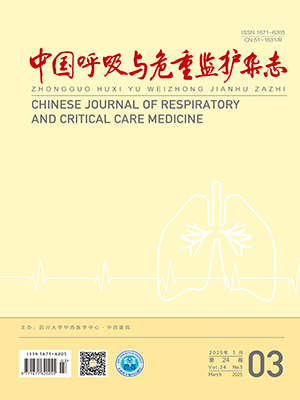| 1. |
Global Initiative for Asthma. Global Strategy for Asthma Management and Prevention, 2021 (GINA, 2021). https://ginasthma.org/.
|
| 2. |
中华医学会呼吸病学分会哮喘学组. 支气管哮喘防治指南(2020年版). 中华结核和呼吸杂志, 2020, 43(12): 1023-1048.
|
| 3. |
中华医学会呼吸病学分会肺功能专业组. 肺功能检查指南(第二部分)——肺量计检查. 中华结核和呼吸杂志, 2014, 37(7): 481-486.
|
| 4. |
中华医学会呼吸病学分会肺功能专业组. 肺功能检查指南(第三部分)——组织胺和乙酰甲胆碱支气管激发试验. 中华结核和呼吸杂志, 2014, 37(8): 566-571.
|
| 5. |
中华医学会呼吸病学分会肺功能专业组. 肺功能检查指南(第四部分)——支气管舒张试验. 中华结核和呼吸杂志, 2014, 37(9): 655-658.
|
| 6. |
Liu L, Zhang X, Zhang L, et al. Reduced bronchodilator reversibility correlates with non-type 2 high asthma and future exacerbations: a prospective cohort study. Respir Med, 2022, 200: 106924.
|
| 7. |
Castro M, Corren J, Pavord ID, et al. Dupilumab efficacy and safety in moderate-to-severe uncontrolled asthma. N Engl J Med, 2018, 378(26): 2486-2496.
|
| 8. |
Wenzel S, Castro M, Corren J, et al. Dupilumab efficacy and safety in adults with uncontrolled persistent asthma despite use of medium-to-high-dose inhaled corticosteroids plus a long-acting β2 agonist: a randomised double-blind placebo-controlled pivotal phase 2b dose-ranging trial. Lancet, 2016, 388(10039): 31-44.
|
| 9. |
Juniper EF, O'Byrne PM, Guyatt GH, et al. Development and validation of a questionnaire to measure asthma control. Eur Respir J, 1999, 14(4): 902-907.
|
| 10. |
Juniper EF, Buist AS, Cox FM, et al. Validation of a standardized version of the Asthma Quality of Life Questionnaire. Chest, 1999, 115(5): 1265-1270.
|
| 11. |
Dweik RA, Boggs PB, Erzurum SC, et al. An Official ATS Clinical Practice Guideline: Interpretation of Exhaled Nitric Oxide Levels (FENO) for Clinical Applications. Am J Respir Crit Care Med, 2011, 184(5): 602-615.
|
| 12. |
Graham BL, Steenbruggen I, Miller MR, et al. Standardization of Spirometry 2019 Update. An Official American Thoracic Society and European Respiratory Society Technical Statement. Am J Respir Crit Care Med, 2019, 200(8): e70-e88.
|
| 13. |
Han YY, Zhang X, Wang J, et al. Multidimensional Assessment of Asthma Identifies Clinically Relevant Phenotype Overlap: A Cross-Sectional Study. J Allergy Clin Immunol Pract, 2021, 9(1): 349-362. e18.
|
| 14. |
Wang G, Wang F, Gibson PG, et al. Severe and uncontrolled asthma in China: a cross-sectional survey from the Australasian Severe Asthma Network. J Thorac Dis, 2017, 9(5): 1333-1344.
|
| 15. |
Friedman J, Hastie T, Tibshirani R. Regularization paths for generalized linear models via coordinate descent. J Stat Softw, 2010, 33(1): 1-22.
|
| 16. |
Hastie T, Tibshirani R, Tibshirani R. Best subset, forward stepwise or lasso? Analysis and recommendations based on extensive comparisons. Stat Sci, 2020, 35(4): 579-592.
|
| 17. |
Li M, Ma ZW, Deng SJ, et al. Development and validation of a noninvasive prediction model for identifying eosinophilic asthma. Respir Med, 2022, 201: 106935.
|
| 18. |
Flood-Page P, Swenson C, Faiferman I, et al. A study to evaluate safety and efficacy of mepolizumab in patients with moderate persistent asthma. Am J Respir Crit Care Med, 2007, 176(11): 1062-1071.
|
| 19. |
Haldar P, Brightling CE, Hargadon B, et al. Mepolizumab and exacerbations of refractory eosinophilic asthma [published correction appears in N Engl J Med, 2011, 364(6): 588.]. N Engl J Med, 2009, 360(10): 973-984.
|
| 20. |
Zhao B, Zheng HM, Li XP, et al. Evaluation of the peripheral blood eosinophil count as a predictor for fractional exhaled nitric oxide or bronchodilator reversibility test outcome. Allergy Asthma Proc, 2021, 42(3): 228-234.
|
| 21. |
Milger K, Skowasch D, Hamelmann E, et al. Bronchodilator reversibility in the GAN severe asthma cohort[J/OL]. J Investig Allergol Clin Immunol, [2022-08-24].
|
| 22. |
Hao HJ, Bao WP, Xue YS, et al. Spirometric changes in bronchodilation tests as predictors of asthma diagnosis and treatment response in patients with FEV1 ≥ 80% predicted. J Allergy Clin Immunol Pract, 2021, 9(8): 3098-3108. e4.
|





 Baidu Scholar
Baidu Scholar